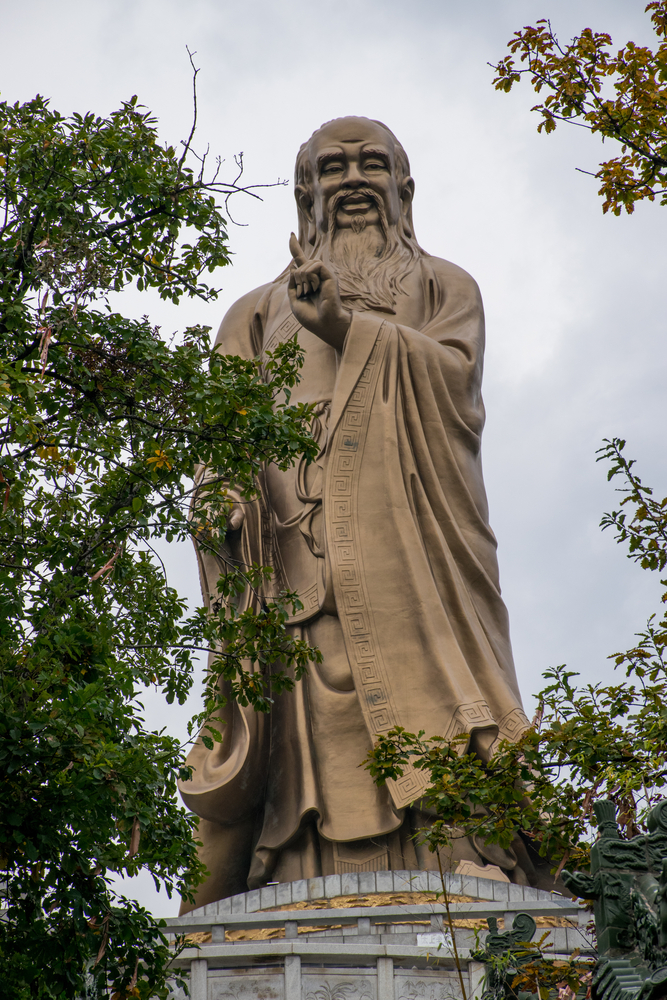Religion: Folk and Traditional Religions
Taoism
Introduction: Taoism is a religious and philosophical tradition that emphasizes living in harmony with the Tao, which is believed to be the fundamental force underlying everything in existence. Taoism originated in China and has been practiced for over 2,000 years and may stem from ancient folk traditions. Tao in Mandarin Chinese means "the way," and is considered a guiding and eternal principle of the universe, with living a moral life a foundational belief.
Origin: Taoism originated in China sometime between 500 to 400 BCE, with the writings of Laozi (Lao Tzu), who is considered the founder of Taoism. He wrote the Tao Te Ching, which is considered the religion's fundamental text. The philosophy was further developed by Zhuangzi and other Chinese philosophers.
History: Taoism has a rich and complex history, with a few different schools of thought and practices. It has been influenced by Confucianism, Buddhism, and various folk religions. Taoism has gone through periods of growth and decline, with its popularity waxing and waning over the centuries.
Adherents: Taoism is practiced by people of various ethnicities in China as well as other countries, including Japan, Malaysia, Hong Kong, Taiwan, and Vietnam. The religion's followers in these countries total about five million. Estimates on Taoism's worldwide followers are between 10 and 20 million. Taoism is particularly popular in rural China.
Belief System: Taoism is based on the belief in the Tao, which is the natural order of the universe and an impersonal cosmic force that connects all things. Taoism emphasizes living in harmony with the Tao and achieving inner peace and tranquility. Taoists also believe in various deities, including the Three Pure Ones and nature spirits, though not in one supreme god.
Practices: Taoist practices include yoga, meditation, chanting, and Tai Chi, a Chinese martial art focused on slow movements and meditation as well as defense. Taoists seek harmony of mind, body, and spirit as well as reduced self-centeredness and a calm and compassionate attitude. Some Taoists may practice divination.
Rituals, Events, Celebrations
- Qingming Festival: Also known as Tomb-Sweeping Day, this is a time in early April to pay respect to ancestors by cleaning their graves and making offerings of food.
- Chinese New Year: Also known as the Lunar New Year, this day is celebrated between January 21 and February 20 every year and is a time to recognize a new year and gather with family for parades, meals, and fireworks.
- Hungry Ghost Festival: Celebrated on day 15 of the seventh lunar month (July or August) this is a time to appease and honor the spirits of the dead by creating altars and leaving food and other tokens to roaming ancestral spirits who may cause mischief if not appeased.
- Birthday of Laozi (Tao-te Tien-tsun): Celebrated on day 15 of the second lunar month, it honors the founder of Taoism, Laozi (Lao Tzu).
Sacred Texts: The most important text in Taoism is the Tao Te Ching (“Classic of the Way of Power”), attributed to Chinese philosopher Laozi. Other important texts include the Zhuangzi and the Liezi.
Places of Worship: Taoist temples are found throughout China, with most temples built along a mountainside. Among the most important or oldest temples are the White Cloud Temple in Beijing (one of the largest and oldest active Taoist temples in China), Qingyang Palace, and Zhongyue Temple. These temples are known as gong, guan, or miao in Chinese.
Sacred Places: The five sacred Taoist mountains are: Tai Shan, in Shandong province; Hua Shan, in Shaanxi province; Heng Shan Bei, in Shaanxi province; Heng Shan Nan, in Hunan province; and Son Shan, in Henan province.
Leadership Structure: There is no Taoist leadership, as temples are autonomous and individual temples are led by local priests.
Leaders: There have been many important figures in the history of Taoism, including Laozi, Zhuangzi, and Zhang Daoling, the founder of the Way of the Celestial Masters sect of Taoism.
Role in Society: Taoism has played an important role in Chinese society, influencing art, literature, and philosophy. It has also provided a source of spiritual guidance for millions of people over the centuries.
Chinese Folk Religion
Introduction: Chinese folk religion is a diverse collection of beliefs and practices that have been passed down through generations. It combines elements of ancestor veneration, Taoism, Buddhism, Confucianism, and shamanism. It includes the worship of local gods and immortals and deifies almost all aspects of life and nature, which is seen as dualistic. This belief is exemplified by yin and yang spirits which are opposite but interconnected and complementary.
Origin: Chinese folk religion has its roots in ancient Chinese shamanism and animism (the belief that all things, even inanimate objects and natural phenomena, have a spirit), and also has been shaped by the teachings of Taoism, Buddhism, and Confucianism. Its practice was especially prominent among Han Chinese.
History: Chinese folk religion has been practiced in China for thousands of years, and it has gone through periods of decline and revival throughout its history. During the 19th and 20th centuries, many aspects of Chinese folk religion were suppressed or destroyed, but it has since experienced a resurgence in popularity.
Adherents: Chinese folk religion is practiced by a large number of people in China, particularly in rural areas. It is also practiced by overseas Chinese communities.
Belief System: Chinese folk religion is a syncretic belief system that combines elements of ancestor veneration, animism, Taoism, Buddhism, and Confucianism. It emphasizes the importance of harmony between humans and nature, and the cultivation of personal virtues. Chinese folk religion maintains that a good life and afterlife are attained through rituals and the honoring of ancestors.
Practices: Chinese folk religion practices include ancestor veneration, the performance of rituals and ceremonies, divination, and the use of talismans and amulets. These practices are often associated with important life events such as births, weddings, and funerals.
Rituals, Events, Celebrations
- Qingming Festival: Also known as Tomb-Sweeping Day, this is a time in early April to pay respect to ancestors by cleaning their graves and making offerings of food.
- Chinese New Year: Also known as the Lunar New Year, this day is celebrated between January 21 and February 20 every year and is a time to recognize a new year and gather with family for parades, meals, and fireworks.
- Hungry Ghost Festival: Celebrated on day 15 of the seventh lunar month (July or August) this is a time to appease and honor the spirits of the dead by creating altars and leaving food and other tokens to roaming ancestral spirits who may cause mischief if not appeased.
- Dragon Boat Festival: A June festival, the origins are thought to stem from the religious veneration of the dragon, the luckiest animal in the Chinese Zodiac. It also commemorate the death of the Chinese poet, Qu Yuan, and involves dragon boat races and eating wine and dumplings.
Sacred Texts: Chinese folk religion does not have a central text, but it is influenced by a variety of traditional Chinese texts, including the I Ching, an ancient Chinese book about divination, and the Tao Te Ching, Taoism's most important text.
Places of Worship: Chinese folk religion does not have specific places of worship, but there are many temples and shrines dedicated to local gods and ancestors throughout China. Home altars are places of ancestor worship.
Sacred Places: Some sacred places in Chinese folk religion include Mount Tai, Mount Hua, and Mount Heng, as well as Xuanyuan Temple in Huangling, Shaanxi.
Leadership Structure: Chinese folk religion does not have a formal leadership structure, but local priests and mediums play an important role in conducting rituals and ceremonies.
Leaders: Chinese folk religion does not have any notable leaders, but there are many local priests and mediums who are respected and trusted within their communities.
Role in Society: Chinese folk religion plays an important role in shaping Chinese society, particularly in rural areas. It is closely tied to Chinese culture and identity, and it continues to be an important part of the lives of many Chinese people.
Buddhism
Introduction: Buddhism originated in ancient India and was brought to China in the first century CE. It was among the top major belief systems of ancient China. Based on the teachings of Gautama Buddha, he taught that suffering is caused by desire. Buddhists believe in the cycle of rebirth and the concept of karma.
Origin: Buddhism was founded by Gautama Buddha in ancient India around 2,500 years ago. It spread to China in the first century CE via the trade route, the Silk Road, by way of traveling Buddhist monks and was fully incorporated into Chinese culture within 100 years.
History:
Adherents: China has the world's largest Buddhist population, estimated at 185–250 million practitioners, and is also practiced by many overseas Chinese communities. There are two major schools of Buddhism, Theravada and Mahayana, which are different expressions of the same teachings of the historical Buddha.
Belief System: Buddhism is based on the teachings of Gautama Buddha, who taught that suffering is caused by desire and that the way to end suffering is through the Noble Eightfold Path, which includes right understanding, right intention, right speech, right action, right livelihood, right effort, right mindfulness, and right concentration. Buddhists believe that the ultimate goal of human life is to attain enlightenment and break free from the cycle of rebirth and suffering. The concept of karma ("action" or "doing") is an important teaching within Buddhism, where things happen as a result of previous actions.
Practices: Buddhists practice meditation and mindfulness, and some participate in communal worship at Buddhist temples where offering are given to images of Buddha.
Rituals, Events, Celebrations
- Buddha Purnima: Celebrated on the full moon day in May, this day commemorates the birth, enlightenment, and death of Gautama Buddha.
- Kathina Ceremony: This ceremony marks the end of the Buddhist Lent period and involves the offering of robes and other gifts to monks.
- Vassa: Also known as Buddhist Lent, this is a three-month period of spiritual retreat and reflection observed by Buddhist monks and nuns.
- Asalha Puja: Celebrated in July or August, this day marks the Buddha's first sermon and the beginning of the Buddhist monastic tradition.
- Magha Puja: Celebrated on the full moon day in February, this day commemorates a gathering of 1,250 enlightened monks in the presence of the Buddha.
Sacred Texts: The Tripitaka is among the most important sacred texts in Buddhism, and contains the teachings of Gautama Buddha as recorded by his disciples. Other important texts include the Mahayana Sutras and The Tibetan Book of the Dead.
Places of Worship: Buddhist temple are found throughout China, however, worshipping in a temple is not essential for Buddhist worship.
Sacred Places:
Leadership Structure: Buddhist leadership in China is primarily composed of monks and nuns who oversee local temples and monasteries.
Leaders (local) and Dates: Prominent Buddhist leaders in China include the Dalai Lama, the Panchen Lama, and the Karmapa, head of the Karma Kagyu school, one of the four main schools of Tibetan Buddhism.
Role in Society: Buddhism has long played an important role in the history and culture of China. Buddhist teachings and practices have also had an impact on the social and ethical values of Chinese people.
Copyright © 1993—2025 World Trade Press. All rights reserved.

 China
China 
